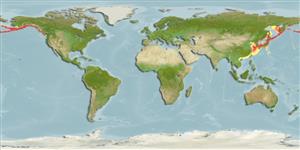Environment: milieu / climate zone / depth range / distribution range
Écologie
marin démersal; profondeur 0 - 604 m (Ref. 50550). Temperate; 66°N -
North Pacific: Hokkaido, Japan to the Bering Sea.
Length at first maturity / Taille / Poids / Âge
Maturity: Lm 26.0, range 24 - 28 cm
Max length : 36.0 cm SL mâle / non sexé; (Ref. 559); common length : 27.0 cm TL mâle / non sexé; (Ref. 56557); poids max. publié: 800.00 g (Ref. 56557); âge max. reporté: 12 années (Ref. 56557)
Description synthétique
Clés d'identification | Morphologie | Morphométrie
Épines dorsales (Total) : 11 - 12; Rayons mous dorsaux (Total) : 20 - 22; Épines anales: 0; Rayons mous anaux: 14 - 19. Three zonal scale rows on body; a scale row of small ctenoid scales under the ventral scale row (Ref. 559). Four preopercular spines, the 2nd longest and simple, the 4th flattened; the first dorsal spine longer than the 2nd (Ref. 559).
Oviparous. Non-copulatory. However according to one study, presence of fertilized eggs in the ovary may have resulted from spermatozoa entering the ovary through the ovarian fluid during spawning, and consequently fertilizing unspawned eggs in the ovaries (Ref. 47168). Fertilized eggs in the ovary develop abnormally however, due to the unavailability of needed elements such as oxygen in the ovary (Ref. 47168).
Masuda, H., K. Amaoka, C. Araga, T. Uyeno and T. Yoshino, 1984. The fishes of the Japanese Archipelago. Vol. 1. Tokai University Press, Tokyo, Japan. 437 p. (text). (Ref. 559)
Statut dans la liste rouge de l'IUCN (Ref. 130435)
Menace pour l'homme
Harmless
Utilisations par l'homme
Outils
Articles particuliers
Télécharger en XML
Sources Internet
Estimates based on models
Preferred temperature (Ref.
123201): 0.7 - 14.7, mean 3.9 °C (based on 374 cells).
Phylogenetic diversity index (Ref.
82804): PD
50 = 0.5156 [Uniqueness, from 0.5 = low to 2.0 = high].
Bayesian length-weight: a=0.00676 (0.00300 - 0.01523), b=3.17 (2.98 - 3.36), in cm total length, based on LWR estimates for this (Sub)family-body shape (Ref.
93245).
Niveau trophique (Ref.
69278): 3.6 ±0.1 se; based on diet studies.
Résilience (Ref.
120179): Faible, temps minimum de doublement de population : 4,5 à 14 années (tm = 5-6).
Fishing Vulnerability (Ref.
59153): Low to moderate vulnerability (34 of 100).
